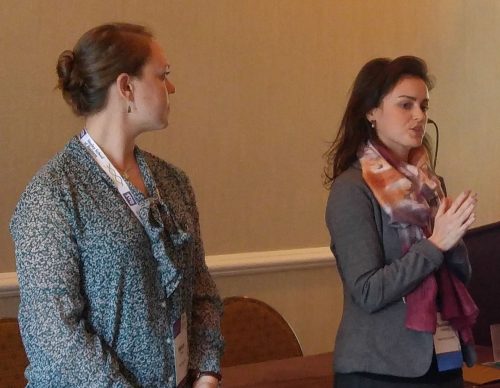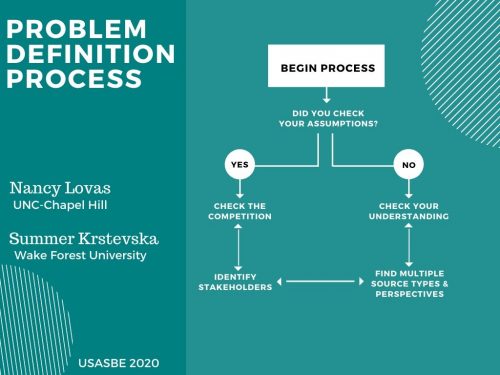After a great (but cold) holiday trip to New Hampshire, I was lucky enough to get to spend 4 days in New Orleans for the USASBE (United States Association of Small Business & Entrepreneurship) Conference before heading back to Winston-Salem for the start of 2020.
Nancy Lovas (Chapel Hill’s Entrepreneurship Librarian) and myself presented, “The Power of Defining the Problem: A New Model for Teaching Critical Thinking Skills” to a room of about 30 guests. Though it was a short 10 minute presentation, we had many questions and few suggestions, which leads me to believe it was interesting and relevant to the audience of mostly faculty members. Our presentation was accepted in the category of “emerging teaching exercises”; sessions of this type are supposed to pose a question to the audience in an attempt to improve the exercise. *We need this format at library instruction conferences!

Our presentation introduced a model we created for business & entrepreneurship students and faculty inspired from what some of you may have seen as “Four Moves & a Habit”. Our model helps students find and critically think about information that helps them solve business problems. Nancy explained why we came up with the model and I shared two examples of how I have applied the model in my classes. As I mentioned, this is an emerging teaching exercise and still being perfected. One of the suggestions we received was to add a step for re-thinking the problem, a step of which I mistakenly assumed was obvious in the process.

The presentations I attended that stood out were:
Creating a Problem Tree: This Professor, Dan Holland from Utah State, was discussing how students tend to jump into problem-solving without thinking critically about the problem. He presented a problem tree that encourages students to think about the ‘whys’ and ‘what’s stopping us’. Some of the audiences’ suggestions really stood out to me. For example, one colleague suggested having the students identify people who have come up with or are working on solutions for various aspects of the problem (checking the competition if you will) and then from there having them identify any gaps or white space that exists allowing for a unique solution and competitive advantage for whatever solution the students end up coming up with to solve the problem.
Conceptual Combination as a Tool for Teaching Creative Ideation: Professor Jeff Nytch from the University of Colorado shared an ideation activity he uses with his class. In a nutshell, he has students choose two random words that are seemingly unrelated from a hat (ex: tree and oven), he asks them to identify individual properties of both and attempt to combine them to create a product. With this activity Nytch hopes to encourage creativity and unique solutions. This exercise really resonated with me, as Nytch pointed out that his entrepreneurial art students really shine with this activity. Entrepreneurship is interdisciplinary here at Wake and often, when I’m teaching entrepreneurship students, it is not hard to see that the non-business students are struggling with jargon and more technical aspects of the discipline.
TEA Matching Game: This game that Professor Andy Heise from the University of Kansas City presented about encourages students to be confronted by their assumptions about who is an entrepreneur. This game gives students a pile of cards with percentages on them (representing the number of entrepreneurs) and a pile of cards with country names on them. The students are then supposed to match the countries with their percentage. Heise mentioned how often students match the higher percentages with more developed countries and vice-versa when really the opposite is true. I really liked this exercise. Too often do people assume you have to be the next Elon Musk or Steve Jobs to be an entrepreneur. I think this activity will make entrepreneurship more approachable and attainable in the minds of many.
Overall, I was pleasantly surprised with this conference. There were more sessions than I expected that showed entrepreneurship faculty and staff expressing the same concerns that I, and many librarians, worry over; critical thinking, problem solving, assumptions & bias. I was initially intimidated to present there, but truly felt heard when giving the presentation, even despite being one of the few librarians there. Though, this year USASBE had a record number of librarians attending! I hope to attend again soon.

5 Comments on ‘Summer @ USASBE’
What interesting ways to approach teaching, especially in interdisciplinary settings – thanks for sharing, Summer!
Oh, I love the format of the session and now I want to try all of these things! Thanks for the write-up! Great food for thought.
Sounds like a great conference, Summer. And congrats on a successful presentation!
What an interesting set of tools! I love how approachable each is. It is practically turning thinking outside of the box into a game! Thanks for sharing these, and for bravely presenting at a new conference.
I love the simplicity of your model! I also like the sound of the problem tree. Thanks for sharing!